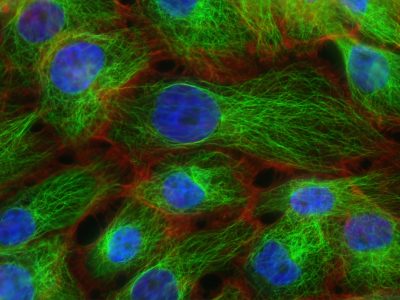
The Ehlers-Danlos syndromes (EDS) and Hypermobility Spectrum Disorders (HSD) are conditions that are not well understood. Most subtypes of EDS are caused by mutations in genes related to collagen, however, when we use microscopes to look at collagen in EDS/HSD, the abnormalities seen are relatively minor, and can also appear in the skin of people without EDS/HSD (see blog 1). Therefore, it was clear these were not the specific cause of weak connective tissue in EDS/HSD patients.
Collagen however, is not the only component of the connective tissue. There are also cells called fibroblasts which show a whole range of molecular changes in EDS/HSD, including an “integrin switch” (described in blog 2). However, it was not understood exactly how this might contribute to the weak connective tissue seen in EDS/HSD.
We performed a literature review, to better understand exactly how fibroblasts and the integrin switch might contribute to the weak connective tissue in EDS/HSD. This led us to propose an updated definition of EDS/HSD and to identify a potential diagnostic biomarker for all EDS/HSD subtypes.
“This led us to propose an updated definition of EDS/HSD and to identify a potential diagnostic biomarker for all EDS/HSD subtypes.”
Summary points from the review:
We hypothesise that EDS/HSD could be a disorder of membrane-bound collagen, which occurs when fibroblasts can no longer attach to collagen. Their failure to then adequately implement the tensional homeostasis mechanism is what may then cause the abnormal connective tissue in EDS/HSD.
If this theory is correct, we suggest analysing skin biopsies for the amount of membrane-bound collagen would make an ideal diagnostic test to identify any form of EDS/HSD, since it bypasses the need of knowing the patients specific genetic basis. This is particularly important for the diagnosis of hEDS/HSD for which the genetic and molecular basis still remains elusive.
The full review can be read here.
“We hypothesise that EDS/HSD could be a disorder of membrane-bound collagen, which occurs when fibroblasts can no longer attach to collagen.”
Acknowledgments: We would like to thank Dr Gemma Pearce, Dr Emma Reinhold, and the Midlands Integrative Biosciences Training Partnership (MIBTP) funded by the Biotechnology and Biological Sciences Research Council (BBSRC), for supporting this work.
Citation: Malek, S. & Köster, DV. (2021). The role of cell adhesion and cytoskeleton dynamics in the pathogenesis of the Ehlers-Danlos syndromes and hypermobility spectrum disorders. Frontiers in Cell and Developmental Biology. Read publication.

PhD Student
Sabeeha is a PhD student and researcher at the University of Warwick, and also interned at hEDStogether. Her research focuses on the role of cell adhesion and cell biomechanics in EDS.

Assistant Professor
Darius is a biophysicist at the University of Warwick. His research interests lie in better understanding the effects of mechanical forces on cell surface biology.
Follow us for the latest on hypermobile Ehlers Danlos Syndrome and Hypermobility Spectrum Disorders.